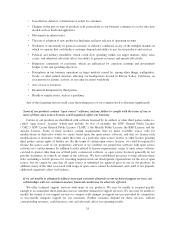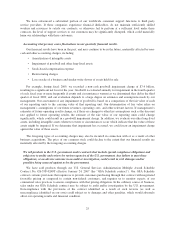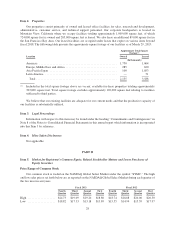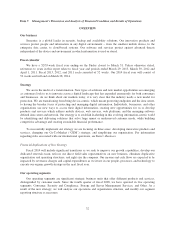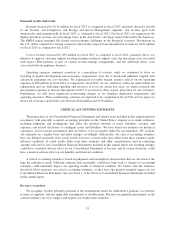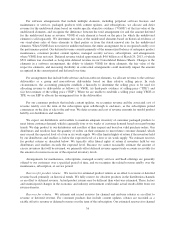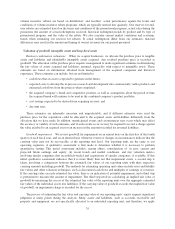Symantec 2013 Annual Report Download - page 124
Download and view the complete annual report
Please find page 124 of the 2013 Symantec annual report below. You can navigate through the pages in the report by either clicking on the pages listed below, or by using the keyword search tool below to find specific information within the annual report.On June 4, 2012, we were advised by the Commercial Litigation Branch of the Department of Justice’s Civil
Division and the Civil Division of the U.S. Attorney’s Office for the District of Columbia that the government is
investigating our compliance with certain provisions of our GSA Schedule contract, including provisions relating
to pricing, country of origin, accessibility, and the disclosure of commercial sales practices. The Department of
Justice has requested that we preserve, among other things, all records relating to GSA Schedule contracting
activity. As reported on the GSA’s publicly-available database, our total sales under the GSA Schedule contract
were approximately $210 million from the period beginning January 2007 and ending December 2011.
We are cooperating with the investigation and we are unable, at this time, to predict the likely outcome. It is
possible that the investigation could lead to claims or findings of violations of the False Claims Act in connection
with our GSA contracting activity. Violations of the False Claims Act could result in the imposition of damages,
including up to treble damages, plus civil penalties in some cases. To the extent the investigation leads to any
such claims or findings, the cost to resolve this matter would adversely affect our operating results and financial
condition. Any negative publicity related to our government customer contracts or any proceedings surrounding
them, regardless of the outcome of this matter, may also damage our business by affecting our ability to compete
for new contracts.
If we are unable to attract and retain qualified employees, lose key personnel, fail to integrate replacement
personnel successfully, or fail to manage our employee base effectively, we may be unable to develop new
and enhanced products and services, effectively manage or expand our business, or increase our revenues.
Our future success depends upon our ability to recruit and retain key management, technical, sales,
marketing, finance, and other personnel. Our officers and other key personnel are employees-at-will, and we
cannot assure you that we will be able to retain them. Competition for people with the specific skills that we
require is significant. In order to attract and retain personnel in a competitive marketplace, we believe that we
must provide a competitive compensation package, including cash and equity-based compensation. The volatility
in our stock price may from time to time adversely affect our ability to recruit or retain employees. In addition,
we may be unable to obtain required stockholder approvals of future increases in the number of shares available
for issuance under our equity compensation plans, and accounting rules require us to treat the issuance of equity-
based compensation as compensation expense. As a result, we may decide to issue fewer equity-based incentives
and may be impaired in our efforts to attract and retain necessary personnel. If we are unable to hire and retain
qualified employees, or conversely, if we fail to manage employee performance or reduce staffing levels when
required by market conditions, our business and operating results could be adversely affected.
From time to time, key personnel leave our company. While we strive to reduce the negative impact of such
changes, the loss of any key employee could result in significant disruptions to our operations, including
adversely affecting the timeliness of product releases, the successful implementation and completion of company
initiatives, the effectiveness of our disclosure controls and procedures and our internal control over financial
reporting, and the results of our operations. In addition, hiring, training, and successfully integrating replacement
sales and other personnel could be time consuming, may cause additional disruptions to our operations, and may
be unsuccessful, which could negatively impact future revenues.
Our effective tax rate may increase, which could increase our income tax expense and reduce (increase) our
net income (loss).
Our effective tax rate could be adversely affected by several factors, many of which are outside of our
control, including:
• Changes in the relative proportions of revenues and income before taxes in the various jurisdictions in
which we operate that have differing statutory tax rates
• Changing tax laws, regulations, and interpretations in multiple jurisdictions in which we operate as
well as the requirements of certain tax rulings
26










